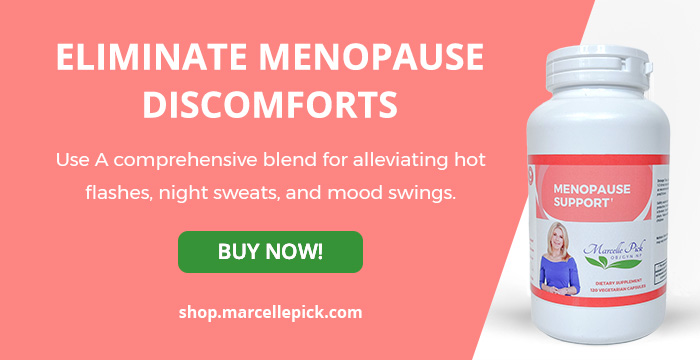Updated: Sept. 28th, 2025
- Estrogen plays an important role in perimenopause and menopause, but it may not be what you think.
- Estrogen dominance is an imbalance of estrogen to progesterone – but it’s more complicated than it may seem at first glance.
- Some symptoms of estrogen dominance include anxiety, migraines, fuzzy thinking, digestive issues, and more.
- Environmental xenoestrogens damage the immune system, create hormonal imbalances, impact fertility, and many are proven carcinogens.
- Try my tips and strategies for managing estrogen dominance, including phytotherapy.
“But my doctor said my issues were probably a drop in estrogen.” That was Rosie’s response after I told her that I thought she was dealing with too much estrogen in her system.
Most conventional doctors do still tell women that the symptoms they experience in premenopause, perimenopause and menopause result from a drop in estrogen production. In their view the solution is estrogen supplementation, or Hormone Replacement Therapy (HRT), usually with synthetic hormones.
In contrast, many alternative practitioners believe that women have too much estrogen, leading to a condition known as “estrogen dominance.” The late healthcare pioneer Dr. John Lee broke new ground when he claimed that estrogen dominance was the real cause of perimenopause and menopause symptoms, especially in younger women. In his view the obvious solution was to rebalance the ratio of estrogen to progesterone through progesterone supplementation.
This idea has led to the marketing of hundreds of brands of progesterone cream and other natural products designed to boost progesterone — all promising a quick fix and miraculous results in curing perimenopausal and menopausal symptoms.
Unfortunately, both of these views are simplistic and misleading for women, because they overlook how dynamic all your hormones are — including DHEA, estrogen, progesterone and testosterone.
Let’s take a look at what estrogen dominance really is, the incredible claims being made for the efficacy of progesterone, and how well your body is equipped to restore the dynamic dance between these hormones when it gets the support it needs.
How do estrogen levels work?
Estrogen and progesterone are two of the primary female sex hormones. During a normal menstrual cycle, they take turns driving the process of maturing and releasing an egg and preparing the uterus for possible pregnancy. Estrogen rises in the first half of the cycle, peaks at ovulation, then falls in the second half as progesterone rises. Progesterone is released by the rupturing of the egg follicle during ovulation. Testosterone, too, is secreted in “surges” around the time of ovulation, perhaps as Mother Nature’s way to increase our interest in sex, and again before menses. If there is no pregnancy, you have a period and the whole cycle begins again.
When estrogen, progesterone and testosterone are doing their jobs properly, they work well together. The amount of each hormone produced at any one time relies on a complicated feedback system between the brain: specifically the hypothalamus and the pituitary gland, which release LH (luteinizing hormone) and FSH (follicle stimulating hormone); the ovaries; and the adrenal glands. Stress and diet affect that feedback system, so they can directly impact your hormonal balance.
What’s critical here is the role of progesterone, which “opposes” the estrogen by helping the body break it down into metabolites that are absorbed and removed in the process. Estrogen stimulates tissue growth, and progesterone signals the body to slough it off.
What is estrogen dominance?
The original concept of estrogen dominance was very simple. Dr. Lee argued that the first sign of menopause is a drop in progesterone production (not estrogen deficiency!). Without enough “opposing” progesterone, estrogen levels stay unnaturally high in the second half of the menstrual cycle. This causes discomfort in a great many women and can lead over time to some severe health consequences.
The history of HRT contains a tragic example of the effects of unopposed estrogen. For many years after its creation, the synthetic estrogen drug Premarin was prescribed to women without any accompanying progesterone. The result was an epidemic of uterine cancer. This eventually led to Premarin being prescribed in tandem with a synthetic progesterone called Provera to protect the uterine lining. Much more recently these two were bundled together and marketed as a new combination drug called Prempro. For decades now, the combination of Premarin with Provera has been the most widely prescribed synthetic HRT in the world.
The role of xenoestrogens
Over time, Dr. Lee’s concept of estrogen dominance evolved to promote another compelling argument: that our overall estrogen levels (in women and men) are too high because of xenoestrogens — man made chemicals in the environment that mimic estrogen in our bodies and act as endocrine disruptors even at minute concentrations.
Scientific studies of wildlife — specifically, frogs and fish — is proving this unfortunate reality to be without doubt. In an interesting twist, researchers worldwide have observed that fish in our lakes and rivers are actually switching gender due to the high levels of effluent estrogens. Even though mainstream media has only begun to recognize this as “news,” experts have been discussing the problem of pharmaceutical pollution for over 25 years, and have known about “gender-bent” fish for nearly 20 years now!
Some surmise these changes to be caused in part by excessive levels of steroids — largely excreted by humans using birth control pills and Hormone Replacement therapy (HRT). Our water treatment facilities are not designed to remove hormonal pollutants. Myriad studies indict environmental estrogens as the cause of reproductive abnormalities in small life forms. So it should come as no surprise that these and other widespread contaminants are now suspected of negatively impacting humans as well, contributing to the problems of estrogen dominance and infertility.
As evidence, it’s often noted that women in Western Europe and the US have estrogen levels that are much higher than women in underdeveloped countries. Many experts link these high levels of estrogen with the rise in breast cancer, autoimmune diseases, infertility and other health issues. They question whether or not xenoestrogens are the cause.
The truth about estrogen dominance
While we all owe a huge debt of gratitude to Dr. Lee for his groundbreaking work on the importance of progesterone in relation to estrogen, to my mind the concept of estrogen dominance is too simplistic, as is the concept of progesterone supplementation.
Since Dr. Lee’s death in October 2003, we have witnessed huge leaps in our biochemical understanding. If he were still with us, I’m sure he would feel vindicated to learn that the latest research indicates many women actually do have normal levels of circulating progesterone. Just as Dr. Lee himself noted, what often throws the balance off is an excess of estrogen, caused by environmental, dietary, and lifestyle factors.
What this all means is that the theory of estrogen dominance is very real, but its significance lies in the overall ratio of estrogen to progesterone — and this ratio is an individualized and dynamic one. Of all women experiencing symptoms of estrogen dominance, some with low levels of progesterone may do very well with progesterone supplementation, whereas others with normal progesterone levels may be better off focusing on changes that can normalize their estrogen or testosterone levels. How do you know where you fit in? The only way to really tell is to have your hormone levels checked and take action from there.
Estrogen dominance as related to premenopause and menopause
It is true that estrogen is often too high relative to progesterone. Most of us who have had PMS are familiar with this temporary form of excess estrogen. Progesterone levels gradually fall during the course of a regular menstrual cycle. In some women this drop may be more precipitous and cause symptoms of PMS.
During premenopause it’s common for estrogen levels to decrease slowly while progesterone levels plummet — a natural result of fewer ovulations, fewer burst follicles and less progesterone. This can cause many of our worst symptoms. See our article on irregular periods and menstrual cycles to learn more.
Calling this state “estrogen dominance” is catchy but misleading. It implies there is one problem, which isn’t true; and not all women experience the condition anyway. And it implies there is one solution, which also isn’t true. Most of the tens of thousands of women I have treated for premenopausal symptoms have suffered not from simple estrogen dominance but from a more fundamental disruption of the body’s ability to maintain hormonal balance. There are usually multiple causes, including stress, emotional factors, and xenoestrogens.
The truth is, healthy hormonal balance is complicated. It isn’t just a matter of not enough progesterone. That’s a little like arguing that menopause is caused by too little estrogen. As you can see from the chart belowm showing how hormones are made in your body, there are lots of players out on the dance floor at any given time.
There’s no simple test for estrogen dominance. But if you have severe symptoms of PMS, premenopause or menopause that don’t respond to a program of increased support for your body within a month or two, you may have persistently higher than normal levels of estrogen (click here to take our Hormonal Health Assessment). Let’s talk about why it’s important to pay attention to these symptoms.
What are the health consequences of estrogen dominance?
Another of Dr. Lee’s contributions was to raise women’s awareness of the profound connections between hormonal imbalance and health.
When estrogen levels are high in relation to our progesterone we experience many severe symptoms, among them anxiety, breast tenderness, cyclical headaches or migraines, depression, digestive issues, fuzzy thinking, palpitations, food cravings, irregular bleeding, water retention, weight gain and more.
It’s important to note that a number of these symptoms are also indicative of the exact opposite condition — a deficiency of estrogen. This is another example of why the concept of estrogen dominance is too simplistic.
If estrogen levels stay unopposed, women may develop infertility, endometriosis, amenorrhea (skipped periods), hypermenorrhea (heavy bleeding), fibroids, uterine cancer, heart disease and stroke, and decreased cognitive ability, among other conditions.
And while I share many of the precepts set forth by Dr. Lee, I am less inclined to think of estrogen, even high levels of estrogen, as universally harmful. I believe every woman is unique, and what may cause harm in one may be fine for another. There have been studies and speculation, for example, about the connection between high levels of estrogen and breast cancer. There are still many unanswered questions about this link.
Estrogen has many wonderful qualities. It creates our fertility, protects our health in myriad ways, and serves as a powerful anti-inflammatory. But I am very concerned about environmental estrogens. They’re another story entirely.
Awash in a sea of xenoestrogens
For the most part, our bodies are amazingly resilient. We are hard-wired to resist threats to our equilibrium. But our bodies are not designed for exposure to the many endocrine disruptors in our environment, among them the family of chemicals known as xenoestrogens.
Pesticides are perhaps the biggest source of xenoestrogens. Most bioaccumulate, meaning they are stored in fat cells of fish, poultry and other food sources in increasing concentration until they reach the top of the food chain — where you and I consume them! They are highly estrogenic, and some experts estimate that the average American ingests over a pound of pesticides a year.
A second major source of xenoestrogens is the many growth hormones given to livestock and poultry, most of which contain fat-soluble estrogens. When we consume those animals or their milk, we ingest that estrogen. Organochlorides like dioxin (a byproduct of chlorine when it is burned or processed), PCB’s, PVC’s, and some plasticizers are just a few of the many man made chemicals that act like estrogen in our bodies. Many others have the effect of interrupting our normal endocrine function, hence the term “endocrine disruptors.”
Many of these xenoestrogens are proven carcinogens. They are also well known for their ability to damage the immune system and interrupt hormonal balance. Our cells can’t always distinguish fully between our own estrogen and xenoestrogens. Every cell has estrogen receptors that recognize and open to the shape of an estrogen molecular chain, regardless of where it comes from.
Mainstream medicine is finally paying attention because xenoestrogens not only affect the cells of women, but those of men and children. Sperm counts have dropped by 50% in some studies, a significant factor in the epidemic of infertility. The age at which girls develop secondary sex characteristics (breasts and pubic hair) is also dropping. It is not exactly clear what role endocrine disruptors as a whole have in the steady rise of chronic diseases in younger and younger children, but studies are underway to evaluate this.
It is easy to see why Dr. Lee’s advice to support our bodies with extra progesterone makes some sense. Let’s examine the role progesterone plays in our bodies and how it can help in hormonal balance.
The role of progesterone and estrogen levels in women
Progesterone is the building block for many other major hormones. Cortisol, testosterone and estrogen are all made from progesterone in a process that begins with cholesterol. Take a look at the chart below of the metabolic pathway.
These hormones are present in our bodies to varying degrees at all times, but only progesterone is readily converted into its sister hormones if needed. Importantly, if we are under a lot of stress and our adrenals are pumping out cortisol, our bodies will take any available progesterone and divert it to meet that demand. If too much progesterone gets diverted for cortisol, as happens when you suffer from adrenal fatigue (take our online Adrenal Health Assessment), there is not enough to make the testosterone needed for a woman’s sexual response — let alone to oppose rising levels of estrogen. No wonder we feel sick, lethargic, and uninterested in sex when we’re under stress!
Insufficient progesterone is hard on our health in other ways too. In addition to reproductive function, all women need normal levels of progesterone to spur new bone growth (and ward off osteoporosis), convert fat into energy, metabolize glucose, and perform many other vital cell functions.
But it’s equally obvious that just adding progesterone isn’t the answer. If stress is creating your hormonal imbalance, adding progesterone will just treat the symptom, not the cause. Because it’s a “moving target,” hormonal balance is never a matter of taking a magic pill. Let’s talk about how to find a solution that works for you.
A woman’s unique path to hormonal balance
In looking at the illustration of the metabolic pathways of progesterone, it’s helpful to think of your endocrine system as a kind of orchestra, and hormonal balance as its music. Each of us has a unique body and biography, so each of us has a unique orchestra and a unique symphony. We all make different demands on our bodies; we all need different kinds of support. Adding any one element to the exclusion of others may make you feel worse, not better. For instance, many women convert progesterone immediately into estrogen; for them, a progesterone supplement will only worsen their imbalance.
There are many women whose bodies, either naturally or due to external factors, produce an abundance of estrogen. I call these patients highly estrogenic, and they are more susceptible to experiencing severe symptoms. They also feel the most dramatic improvement when they add progesterone to their routine.
While genetics have some influence, lifestyle is the single biggest factor in the production and storage of estrogen, progesterone, testosterone, and our other hormones. Our modern diet, filled with refined flour and sugar, simple carbohydrates and artificial ingredients, combined with our lack of exercise, promotes metabolic irregularities that lead to insulin resistance, obesity, digestive problems, and cardiovascular disease, which in turn affect the healthy flow of hormone production shown in the chart above. And, as I detailed earlier, stress can play a major role.
So what can we do about it? Here are some tips for maintaining the right balance.
Limit exposure to xenoestrogens
Limiting our exposure to xenoestrogens is very important. Thoroughly wash or peel all produce to remove at least some of the pesticides. Eating only lean, organic meat and dairy products is wise. Heat food in metal or porcelain containers, not plastic, and definitely not in the microwave with plastic wrap! Drinking out of glass containers instead of plastic, previously used water bottles, or Styrofoam cups is also a good choice.
Eat to promote balance
A diet rich in phytonutrients can protect your hormonal balance. Phytoestrogens, for example, are natural, plant-based substances found in soybeans, licorice, yams, alfalfa and lots of other foods that are thought to bind to estrogen cell receptors and protect them from accepting the more damaging xenoestrogens. Because they work as molecular messengers, abundant botanical and other micronutrients such as essential fatty acids can help increase your body’s ability to listen and dance to the hormonal music.
In addition to eating a plant-rich diet, I recommend taking a high-quality daily nutritional supplement as a very important step towards restoring hormonal balance naturally. The store at MarcellePick.com offers an excellent multivitamin.
Phytotherapy —a gentle approach to a complex issue
If you truly are progesterone deficient, then additional progesterone may be a good solution for you, particularly when used as part of a comprehensive plan that includes healthy lifestyle and dietary support. We’ve seen women respond extremely well to over-the-counter progesterone cream formulations for just weeks or months; others need higher prescription-strength doses over longer time periods. (A comprehensive blood panel will help show whether or not you have a serious hormone deficiency that warrants prescription strength hormone replacement).
If you are like most of the women I see, your hormonal picture is much more complex than a simple estrogen or progesterone deficiency. If you are experiencing moderate to severe, persistent symptoms of hormonal imbalance, or weaning yourself off HRT, you can probably benefit from an approach that incorporates phytotherapy aimed at normalizing the healthy dynamic interplay between all three of your key sex hormones: progesterone, estrogen and testosterone. Herbal therapies like black cohosh, Ashwagandha, chasteberry and others are a gentle, natural way to restore your hormone functions as your body requires. Ancient cultures used these botanical remedies to support, enhance or substitute hormones in an adaptogenic manner, as the body required.
So, if you’ve tried some over-the-counter progesterone products and been disappointed, you may benefit from a more comprehensive approach that combines nutritional and lifestyle modifications with a gentle, but well-balanced botanical formulation. For more information, read our article, “Phytotherapy – The Key To Hormonal Balance?“.
A balanced approach
Like Dr. Lee, I think progesterone supplementation can be an important step towards rejuvenating hormonal balance, but I don’t recommend taking a one-hormone approach. And if your symptoms are ongoing, I encourage you to have your hormone levels monitored on a regular basis. I believe that the gentlest interventions in the hormonal choreography are the ones that restore balance best.
Remember, progesterone can’t restore hormonal balance alone!
When you look at the complete picture, you can find lifestyle changes and gentle solutions that work best for your body.









